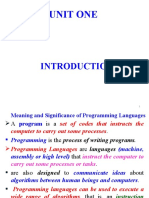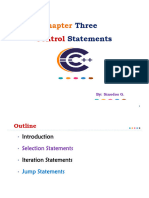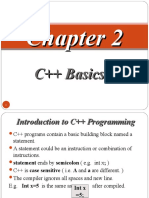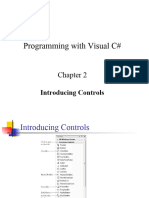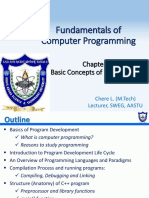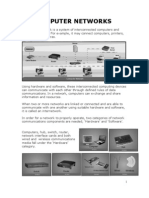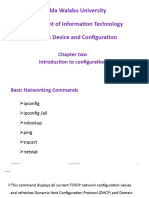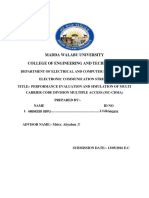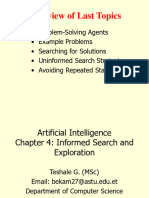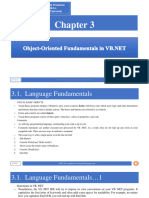CHAPTER-2
Data Communication and Data Transmission
MWU-IT@2023
� 2.1. Description of Data Communication
• Communication can be defined as the exchange of information between
two or more entities.
• In engineering, exchange of information is not only between people,
information exchange also takes place between machines or systems.
• Voice services have seen unprecedented increase in use throughout the
world with the introduction of mobile phones, with embedded data services
such as SMS, and web browsing.
• Data is referred to as a piece of information formatted in a special way.
• Data can exist in a variety of forms, such as numbers or text on pieces of
paper, as bits and bytes stored in electronic memory, or as facts stored in a
person's mind.
• In electronics terms data is a digital bit or digitized analog signal.
• Signals are physical quantity that changes with time.
2
MWU-IT@2023
�• Signal is sequence of pulses in fiber optics cable or electromagnetic
wave irradiated by an antenna.
• When these signals are transfer between two or more points we say data
is transmitted.
• Transmission of data from source to destination usually takes place via
some transmission media and this depends on two main factors; quality
of signal being transmitted and characteristics of transmission medium.
• Data transmission always uses the form of electromagnetic waves and
they are classified into guided electromagnetic waves and unguided
electromagnetic waves.
• Examples of guided waves are twisted pair, coaxial cable and optical
fiber.
• Unguided waves means transmitting electromagnetic waves but they are
not guided as example propagation through air, vacuum and seawater.
3
MWU-IT@2023
� 2.2. Analog and Digital Signal
• The entire world is full of signals, both natural and artificial.
• Signals can be analog or digital.
• The term analog signal refers to signal that is continuous and takes
continuous value.
MWU-IT@2023
�• Figure 1 shows a typical representation of analog signal.
• Because the signal varies with time, time is plotted on horizontal (x-axis), and
voltage on the vertical (y-axis).
• While this signals may be limited to a range of maximum and minimum
values.
• There are still an infinite number of possible values within that range.
• For example the analog voltage that light the bulbs is clamped between -220V
and +220V, but as you increase the resolution more and more, you discover
an infinite number of values that the signal can be.
• A digital signal is a physical signal that is a representation of a sequence of
discrete values.
• The signal must have a finite set of possible values, the number of set which
can be anywhere between two and very large number that is not infinity.
• Digital signal is one of two voltage value (0V or 5V) timing graphs of these
signals look like square waves as shown in figure 2.
5
MWU-IT@2023
� 2.3. Components of Data Communication
• Basic Components of data communication are:
– Source: It is the transmitter of data. Examples are: Terminal, Computer,
Mainframe etc.
– Medium: The communications stream through which the data is being
transmitted. Examples are: Cabling, Microwave, Fiber optics, Radio
Frequencies (RF), Infrared Wireless etc.
– Receiver: The receiver of the data transmitted. Examples are: Printer,
Terminal, Mainframe, and Computer.
MWU-IT@2023
� 2.3.1 Source
• The source generates the information or data that will be transmitted to the
destination.
• Popular forms of information include text, numbers, pictures, audio, video
or a combination of any of these.
• Information are put together in analog or digital form and broken into
group or segment of data called packets.
• Each packet consists of the following:
➢ The actual data being sent
➢ Header
➢ Information about the type of data
➢ where the data came from
➢ where it is going, and
➢ How it should be reassembled so the message is clear and in order
when it arrives at the destination. 7
MWU-IT@2023
� 2.3.2 Transmitter, Transmission Medium, Receiver and
Destination
• The transmitter a device used to convert the data as per the destination
requirement.
• For example a modem, converts the analog (telephonic) signal to digital
(computer) signals and alternatively digital to analog.
• The transmission medium is the physical path by which data travels from
transmitter to receiver.
• Example of such channels is copper wires, optical fibers and wireless
communication channels etc.
• This receives the signals from the transmission medium and converts it into
a form that is suitable to the destination device.
• For example, a modem accepts analog signal from a transmission channel
and transforms it into digital bit stream which is acceptable by computer
system.
• It is simply a device for which source device sends the data.
8
MWU-IT@2023
� 2.4. TRANSMISSION MODES AND DATA FLOW
• Data Transmission mode defines the direction of the flow of
information between two communication devices.
• It is also called Data Communication or Directional Mode.
• It specifies the direction of the flow of information from one place to
another in a computer network
• Types of Transmission Mode
➢ Simplex Transmission
➢ Half Duplex Transmission
➢ Full Duplex Transmission
MWU-IT@2023
� 2.4.1. Simplex Transmission
• In simplex mode, the communication is unidirectional, as on a one-way
street.
• Only one of the two devices on a link can transmit; the other can only
receive.
• Keyboards and traditional monitors are examples of simplex devices. The
keyboard can only introduce input; the monitor can only accept output.
• The simplex mode can use the entire capacity of the channel to send data in
one direction. Examples are Radio and Television broadcasts. They go
from the TV station to your home television.
10
MWU-IT@2023
� 2.4.3 Full Duplex Transmission
• In full-duplex mode, both stations can transmit and receive simultaneously.
• The full-duplex mode is like a two way street with traffic flowing in both
directions at the same time.
• One common example of full-duplex communication is the telephone
network.
• When two people are communicating by a telephone line, both can talk and
listen at the same time.
11
MWU-IT@2023
� 2.4.3 Half Duplex Transmission
• In half-duplex mode, each station can both transmit and receive, but not at
the same time.
• When one device is sending, the other can only receive, and vice versa.
• The half-duplex mode is like a one-lane road with traffic allowed in both
directions.
• When cars are traveling in one direction, cars going the other way must
wait.
• In a half-duplex transmission, the entire capacity of a channel is taken over
by whichever of the two devices is transmitting at the time.
12
MWU-IT@2023
� 2.5. Data Communication Criteria
• The effectiveness of data communications system depends on four fundamental
characteristics:
1) Delivery: The system must deliver data to the correct destination. Data must be
received by the intended device or user and only by that device or user.
2) Accuracy: The system must deliver the data accurately. Data that have been
altered in transmission and left uncorrected are unusable.
3) Timeliness: The system must deliver data in a timely manner. Data delivered late
are useless. In the case of video and audio, timely delivery means delivering data as
they are produced, in the same order that they are produced, and without significant
delay. This kind of delivery is called real-time transmission and this occurs in a
real-time system.
4) Jitter: Jitter refers to the variation in the packet arrival time. It is the uneven delay
of delivery of audio or video packets. For example, let us assume that video
packets are sent every 20ms. If some of the packets arrive with 20ms delay and
others with 30ms delay, an uneven quality in the video is the result.
13
MWU-IT@2023
� 2.6. Data Communication And Terminal Equipment
• Extensive telegraph and telephone networks were established all over the
world, decades before the emergence of computers.
• Data communication equipment (DCE) is the hardware devices that can be
used to establish, maintain and terminate communication between a data
source and its destination.
• Data communications equipment is most used to perform signal exchange,
coding and line clocking tasks as part of intermediate equipment or DTE. A
typical example of data communication equipment is the modem.
• Data terminal equipment (DTE) refers to the interface equipment which is
source or destination in communication.
• The terminal equipment is capable of converting information to signals and
also reconverting received signals.
• Popular examples of data terminal equipment are computers, printers, routers,
servers etc.
14
MWU-IT@2023
�• Data communication equipment and data terminal equipment are often
confused with each other.
• In fact the confusion is more pronounce when data communication
equipment are embedded in some data terminal equipment.
• The truth is that when the two are separated they are interlinked.
• Also, data terminal equipment and data communication connectors are
wired differently if a single straight cable is employed.
• Data communication equipment generates internal clock signals, while
data terminal equipment works with externally provided signals.
• Figure 4: Data communication and terminal equipment
15
MWU-IT@2023
� 2.7. Digital Data Transmission Methods
• In digital data transmission where we have more than one bits to send from
sender to receiver.
• Do we send 1 bit at a time; or do we group bits into larger groups and, if so, how?
• The transmission of binary data across a link can be accomplished in either
parallel or serial mode. In parallel mode, multiple bits are sent with each clock
tick.
• In serial mode, 1 bit is sent with each clock tick. While there is only one way to
send parallel data, there are three subclasses of serial transmission: asynchronous,
synchronous, and isochronous.
• Figure-5: Data Transmission
16
MWU-IT@2023
� 2.7.1 Parallel Transmission
• Binary data, consisting of 1s and 0s, will be organized into groups of n bits each.
• Computers produce and consume data in groups of bits. By grouping, we can send
data n bits at a time instead of 1. This is called parallel transmission.
• The advantage of parallel transmission is speed.
• All else being equal, parallel transmission can increase the transfer speed by a
factor of n over serial transmission.
• Shortcoming of parallel transmission it requires n communication lines just to
transmit the data stream. Hence it is expensive, parallel transmission is usually
limited to short distances.
• Figure-6: Parallel transmission
17
MWU-IT@2023
� 2.7.2 Serial Transmission
• In serial transmission one bit follows another, so we need only one communication
channel rather than n to transmit data between two communicating devices.
• The advantage of serial over parallel transmission is that with only one
communication channel, serial transmission reduces the cost of transmission over
parallel by roughly a factor of n.
• Since communication within devices is parallel, conversion devices are required at
the interface between the sender and the line (parallel-to-serial) and between the
line and the receiver (serial-to-parallel).
• Serial transmission occurs in one of three ways: asynchronous, synchronous, and
isochronous.
• Figure 7: Serial Transmission
18
MWU-IT@2023
� 2.7.2.1 Synchronous Transmission
• In synchronous transmission, we send bits one after another without start or
stop bits or gaps. It is the responsibility of the receiver to group the bits.
• Figure-8: Synchronous Transmission
19
MWU-IT@2023
� 2.7.2.2 Isochronous Transmission
• A sequence of events is isochronous if the events occur regularly, or at
equal time intervals.
• The isochronous transmission guarantees that the data arrive at a fixed rate.
In real-time audio and video, in which uneven delays between frames are
not acceptable, synchronous transmission fails.
• For example, TV images are broadcast at the rate of 30 images per second;
they must be viewed at the same rate.
• If each image is sent by using one or more frames, there should be no
delays between frames.
20
MWU-IT@2023
� 2.7.2.3 Asynchronous Transmission
• In asynchronous transmission, we send start bit (0) at the beginning and 1
or more stop bits (1) at the end of each byte.
• There may be a gap between each byte.
• Figure 21: Asynchronous Transmission
21
MWU-IT@2023
� 2.8. Transmission Media Problems and Impairment
• Data is transmitted through transmission medium which are not perfect.
• The imperfection causes signal impairment.
• Due to the imperfection error is introduced in the transmitted data i.e. the
original signal at the beginning of the transmission is not the same as the
signal at the Receiver.
• Some of the transmission media/impairment problems are:
➢ Attenuation Distortion
➢ Crosstalk
➢ Echo or Signal Return
➢ Noise
22
MWU-IT@2023
� 2.8.1 Attenuation Distortion
• Attenuation results in loss of energy.
• When a signal travels through a medium, it loses some of its energy in
overcoming the resistance of the medium.
• To compensate for this loss, amplifiers are used to amplify the signal.
• Figure below shows the effect of attenuation and amplification.
• The loss of signal or attenuation is measured at the receiving end and
compared to a standard reference frequency.
• Figure 5: effect of attenuation and amplification.
23
MWU-IT@2023
� 2.8.2. Crosstalk
• Crosstalk is when one line induces a signal into another line.
• In voice communications, we often hear this as another conversation going on in
the background.
• In digital communication, this can cause severe disruption of the data transfer.
• Cross talk can be caused by overlapping of bands in a multiplexed system or by
poor shielding of cables running close to one another.
• There are no specific communications standards applied to the measurement of
crosstalk.
• Figure 6: Crosstalk impairment
24
MWU-IT@2023
� 2.8.3. Echo or Signal Return
• All media have a preferred termination condition for perfect transfer of
signal power.
• The signal arriving at the end of a transmission line should be fully
absorbed otherwise it will be reflected back down the line to the sender and
appear as an Echo.
• Echo Suppressors are often fitted to transmission lines to reduce this effect.
• Normally during data transmission, these suppressors must be disabled or
they will prevent return communication in full duplex mode.
• Echo suppressors are disabled on the phone line if they hear carrier for
400ms or more. If the carrier is absent for 100 mSec, the echo suppressor is
re-enabled.
• Echo Cancellers are currently used in Modems to replicate the echo path
response and then combine the results to eliminate the echo. Thus no signal
interruption is necessary.
25
MWU-IT@2023
� 2.8.4. Noise
• Noise is any unwanted signal that is mixed or combined with the original
signal during transmission.
• Due to noise the original signal is altered and signal received is not same as
the one sent.
• Noise is sharp quick spikes on the signal caused from electromagnetic
interference, lightning, sudden power switching, electromechanical
switching, etc.
• These appear on the telephone line as clicks and pops which are not a
problem for voice communication but can appear as a loss of data or even
as wrong data bits during data transfers.
26
MWU-IT@2023
� 2.9 Elements of a Network
• The modern data network has become a critical asset for many industries.
• Most basic data networks are designed to connect users and enable them to
access various resources, like the Internet and other computers connected to
the network.
• Networks are comprised of four basic elements:
– hardware,
– software,
– protocols and
– connection medium.
27
MWU-IT@2023
� 2.9.1 Hardware
• The backbone of any network is the hardware that runs it. Network
hardware includes network cards, routers or network switches, modems and
Ethernet repeaters.
• Without this hardware, computers have no means of accessing a network.
• Network cards give computers direct access to network media and enable
them to connect to other equipment, including routers, switches, modems
and repeaters.
• Routers or switches allow a single network connection from a modem to be
divided between several computers.
• Repeaters refresh the network signal between Ethernet cable segments,
allowing Category 5 cables to reach beyond their 300-foot maximum
length without signal loss.
28
MWU-IT@2023
� Software
• In order for the hardware to interact with the network, it needs software to
issue commands.
• The primary form of networking software is protocols -- software that
instructs network devices on how to connect to the network and how to
interact with one another.
• Other examples of networking software include connection monitoring
software, networking clients and other tools designed to further facilitate
your computer's ability to connect to the network.
• Connection media
• The medium used to connect the nodes of a network varies with the type of
network.
• Wired networks will often use network cables like Category 5 Ethernet
cables, while wireless networks make direct connections between devices
using radio signals as the medium.
29
MWU-IT@2023
� 2.10 Transmission media
• In data communication terminology, a transmission medium is a
physical path between the transmitter and the receiver i.e. it is the
channel through which data is sent from one place to another.
Transmission Media is broadly classified into the following types:
1. Guided Transmission media: use cable or wire to transfer data between
the source and destination.
✓ Telephone line
✓ Twisted pair cable
✓ Coaxial cable
✓ Fiber optic cable
2. Unguided Transmission media: those transmission media use wireless
connection among device.
✓ Air
✓ Microwave, infrared, vacuum
30
� End of Chapter-2
READ THE REFERENCE BOOK
FOR DETAIL INFORMATION
31
MWU-IT@2023











